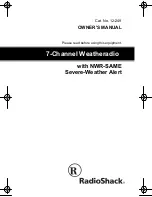
4
6. Check the cable for correct connection and test all the components for correct functionality by
manually turning the wind-gauge; tilting the optional rain sensor to hear the impact of the internal
moving seesaw, etc. (See
Positioning
below).
7. Time and date must be manually set (See
Manual Setting
below).
8. After the Weather Center has been tested and found fit, the initial set up of the weather station
system is finished and the mounting of the system components can take place. Ensure that all
components work properly together at their chosen mounting or standing locations before permanent
mounting.
For example, if there appears to be problems with the 915 MHz radio transmissions, they can often
be overcome by slightly changing the mounting locations or turning the base station.
NOTE:
The radio communication between the receiver and the transmitters in the open field reaches distances of
up to 330 feet/ 100 meters, provided there are no interfering obstacles such as buildings, trees, vehicles,
high voltage lines, etc.
9. Radio interferences created by cordless phones, PC screens; radios or TV sets can in some cases
entirely cut off radio communication. Please consider this when choosing standing or mounting
locations.
NOTE:
After batteries are installed in the transmitter, install the batteries in the weather center to receive the
signal from the transmitters as soon as possible. If the weather center is powered more than 5 hours
after the transmitter is powered, the weather center will never receive signal successfully from the
transmitters. In this case, you will need to reinstall the batteries from all the transmitters to redo set-up
procedure.
After batteries are installed, there will be synchronization between Weather Center and the
transmitters. At this time, the signal reception icon will be blinking. When the signal is successfully
received by the Weather Center, the icon will be switched on (If it is not successful, the icon will
not be shown).
The short blinking of the icon shows that a reception is in progress.
If the signal reception is not successful on the first frequency (915MHz) for 45 seconds, the frequency
is changed to 920MHz and the learning is tried another 45 seconds. If still not successful, the
reception is tried for 45 seconds on 910MHz. This will also be done for re-synchronization.
HOW TO INSTALL AND REPLACE THE BATTERIES INTO THE THERMO-HYGRO TRANSMITTER
The outdoor Thermo-hygro transmitter works with 2 x AA IEC LR6, 1.5V batteries. To
install and replace the batteries, please follow the steps below:
1. Remove the airflow cover of the transmitter.
2. Remove the battery compartment cover.
3. Insert the batteries, observing the correct polarity (see the marking in the battery
compartment).
4. Replace the battery cover and the airflow cover onto the unit.
Transmitter signal
reception icon





































